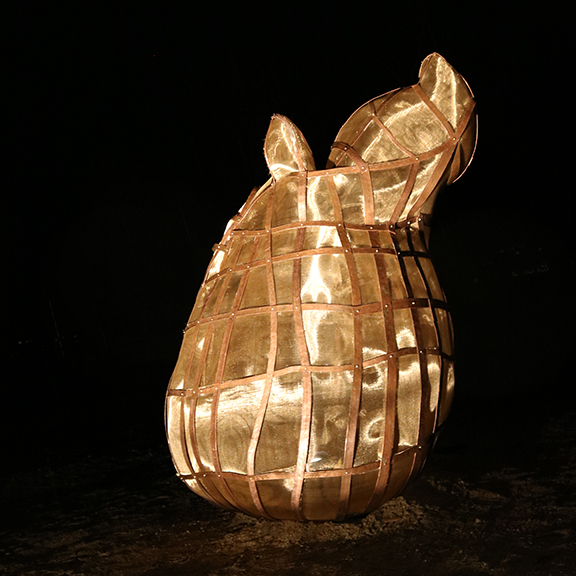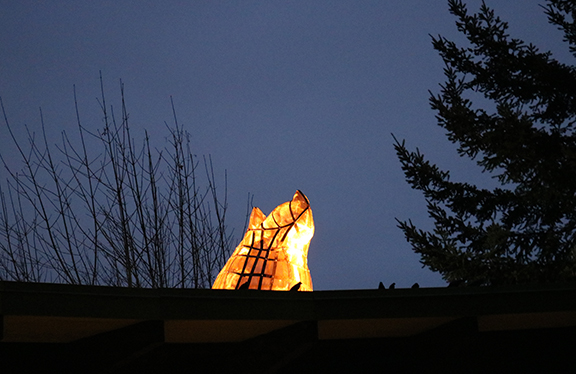WORK | BIO | CONTACT
KATHERINE SHAUGHNESSY
| Tempest-tost |

Tempest-tost
5'h x 4'w x 4'd, copper, solar-powered lights, 2019
Please contact me if you are interested in purchasing.
The Statue of Liberty, titled "Liberty Enlightening the World," was designed by French sculptor Frédéric Auguste Bartholdi.
It was dedicated on October 28, 1886.
The statue was meant to commemorate the recent end of slavery in the United States
(note that the Lady is standing on broken chains).
But over the years, perhaps because of its location - in the New York Harbor on Liberty Island near Ellis Island,
once the main entry for immigrants coming to the U.S.A. - it has come to symbolize immigration and the nation's "welcoming" spirit.
Emma Lazarus of New York first ignited this idea in 1883, when in an effort to raise money to build the statue's pedestal,
she wrote the now-famous poem "The New Colossus," which ends with these much-quoted lines:
"Give me your tired, your poor,
Your huddled masses yearning to breathe free,
The wretched refuse of your teeming shore.
Send these, the homeless, tempest-tost to me,
I lift my lamp beside the golden door!"
But in the 1880s, even though the Civil War had ended a generation ago with the Emancipation Proclamation,
not all Americans had full rights of citizenship. Women didn't have the right to vote and segregation was law.
The Cleveland Gazette, a black-owned newspaper in Cleveland, Ohio, lambasted the Statue of Liberty for its false piety:
"Liberty enlightening the world," indeed! The expression makes us sick. This government is a howling farce.
It can not or rather does not protect its citizens within its own borders. Shove the Bartholdi statue, torch and all, into the ocean until the "liberty"
of this country is such as to make it possible for an inoffensive and industrious colored man to earn a respectable living for himself and family,
without being ku-kluxed, perhaps murdered, his daughter and wife outraged, and his property destroyed.
The idea of the "liberty" of this country "enlightening the world," or even Patagonia, is ridiculous in the extreme."
("Postponing Bartholdi's statue until there is liberty for colored as well." The Cleveland Gazette. Cleveland, Ohio. November 27, 1886.)
It's true that 133 years ago the Statue of Liberty was premature in its commemoration of freedom for all Americans.
And now, decades after full suffrage, Lady Liberty as the welcoming symbol of America can ring a bit hollow.
Walls continue to be erected on the southern U.S. border. More and more refugees are being turned away.
The chains of racism are being forged anew.
Yet the spirit of Lady Liberty is enduring. The tall woman, torch in hand, remains a surprisingly powerful symbol.
The statue is instantly recognizable. She still provides a guiding light. She is still challenging America to be both compassionate and enlightened.
Bartholdi's statue was made of copper attached to an interior skeleton of steel designed by Gustave Eiffel.
The original torch had construction and functional problems from the beginning.
To top it off, in 1916, Germans detonated carloads of dynamite on a nearby peninsula, killing seven people and damaging the statue,
especially the torch-bearing right arm. The torch went through a major reconstruction by sculptor Gutzon Borglum (of Mount Rushmore fame).
He removed much of the original copper creating a latticework of copper with 600 stained glass windows, and with the addition of electrical power,
the torch glowed from within like a lantern. By 1984, the torch, which was again in serious need of repair,
was removed and replaced with a 24k gold-leafed replica that was lit with spotlights shining on it from the outside.
To this day, the original copper torch is not on the statue, but located in a museum on the island.
A year before the pandemic, my mother and sisters and I took a trip to New York City.
I know the city well, but had never thought much of how it fits into my family history.
My mother's family came from Ireland in the early 1900s via Ellis Island and initially settled in Manhattan, where my great grandfather opened a bakery.
They would have seen the young Statue of Liberty as their ship approached America. They eventually settled in Cleveland.
Together my family and I walked the halls of Ellis Island and then climbed up and into the statue.
It was powerful to stand in those giant halls imagining our ancestors arriving 100 years ago.
For me, it was a jumble of contradictory emotions: the Statue of Liberty as a beacon of enlightenment, the criticisms from the Cleveland Gazette,
the Lazarus promise to those "yearning to be free," the present-day need for such a symbol.
And so, my desire to recreate the flame began. I am still torn by what I see our government and my fellow citizens doing and saying to the refugees
and to immigrants, to the individuals, to the families, to the children who want and/or need to come to the United States today.
I used to live not far from the U.S./Mexico border. Before Tempest-tost, I made another work, weaving miniature
bridges
in memory of three children who died while in U.S. custody there.
My version of the flame, Tempest-tost, is made from hammered copper pipe that I collected from a Boise scrap yard.
It's constructed like a basket, with the flattened and bent pipes woven together, one by one, bolted at the intersections.
Instead of stained glass, I used copper screening. Lit by solar-powered lights, it stands 5 feet tall and 4 feet wide.
The title comes from the 13th line of Lazarus' poem. "Tempest-tost," is an adjective meaning pounded or hit repeatedly by storms or adversities; buffeted, storm-tossed;
troubled; characterized by or indicative of distress or affliction or danger or need.
Tempest-tost was exhibited at the Port Angeles Fine Arts Center in Washington in their 2019/20 Wintertide exhibition on their low-slung, flat roof with a sightline to the ocean via the Strait of Juan de Fuca,
on the northwestern border of the United States. Currently, Tempest-tost is on view in Seattle at Equinox Studios.

Tempest-tost
5'h x 4'w x 4'd, copper, solar-powered lights, 2019
(installation view, Port Angeles Fine Arts Center in Washington)

Tempest-tost
5'h x 4'w x 4'd, copper, solar-powered lights, 2019
(installation view, Port Angeles Fine Arts Center in Washington)

Tempest-tost (artist's sketch)
ink on paper, 2019

Tempest-tost (artist's sketch)
ink on paper, 2019
Copyright Ⓒ 1998-2021 Katherine Shaughnessy